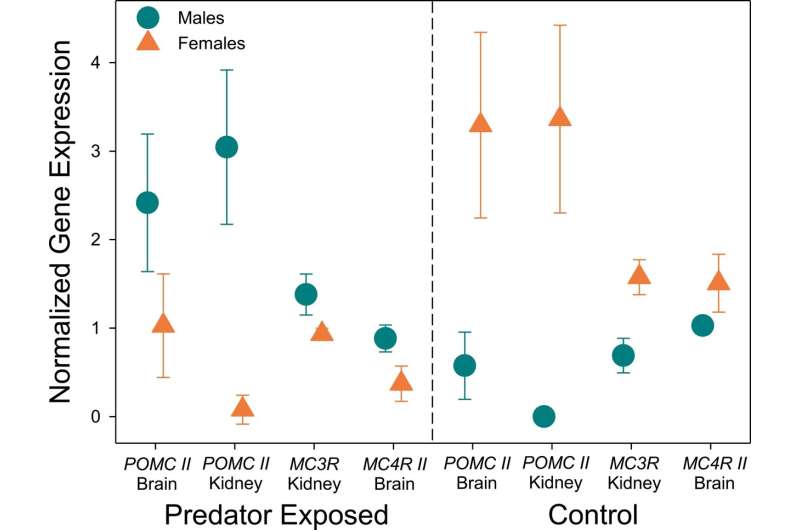This article has been reviewed according to Science X's editorial process and policies. Editors have highlighted the following attributes while ensuring the content's credibility:
fact-checked
peer-reviewed publication
trusted source
proofread
Stress may trigger male crucian carp defense against predators

Only males among the fish species crucian carp have developed a strategy to protect themselves from hungry predators, according to a new study from Lund University in Sweden published in the journal Evolution. The explanation could lie in that the surrounding environment affects the stress system in males and females differently.
Some animals have evolved the ability to swiftly change appearance to defend themselves against predators when necessary—while avoiding the unnecessary costs of that appearance when it is not needed. This is an advantage for animals that live in environments where the risk of being eaten by predators varies. However, there is a difference in the ability of females and males to escape the enemy in this way. Researchers at Lund University have investigated the crucian carp fish species.
"When the smell of predatory fish spreads in the water, the male crucian carp begins to change its appearance, much like a character from Transformers. From having grown in length, the presence of the predatory fish causes the male carp to instead grow in height. The new body shape makes it much more difficult for gape-size limited predators to swallow them. The shape also provides better acceleration, which is an advantage when the fish has to escape from an attacking pike," explains Jerker Vinterstare, biologist at Lund University.
In water without predatory fish, no difference is visible between crucian carps of different sexes. However, since females and males generally differ in how they reproduce, a combined lab and field experiment was conducted to test whether this difference affects the individual's ability to defend itself against predatory fish.
"The males had a clear defense against the lakes' predatory fish, which the females did not. In the next step, we took crucian carp from a predator-free lake and exposed half of them to pike under controlled laboratory conditions. After six months, we analyzed the appearance of the carp—here, too, the results were clear. During these six months, the males had altered their bodies and grown in height, which the females had not," says Jerker Vinterstare.
In general, females invest more in offspring than males, an inequality that is relatively common in the animal kingdom and could explain why some individuals seem to have more energy to devote to defending themselves against predators. While more females fall prey to predators given their lack of strategy against them, it is also believed that females attempt to partially compensate this by being more risk-averse.
Although the ability of the crucian carp to change its body shape depending on the risk of predatory fish attacks is known, we do not know how this body change is regulated physiologically.
However, previous studies have been able to link stress hormones to the appearance-based defense. To increase the understanding of what lies behind this—and to see if there are differences between the reactions of females and males—the researchers analyzed the genes in the animals' stress system. This was done with females and males that either lived with or without a pike for six months.
"We found strong evidence that males and females react completely differently to the stress caused by the presence of a pike. The males increased the expression of stress genes, while the females decreased the expression of the same genes. This may indicate that males react differently to predator-induced stress, compared to females—and that this difference may explain why females and males look different in the presence of predatory fish," concludes Jerker Vinterstare.
More information: Jerker Vinterstare et al, Sex matters: predator presence induces sexual dimorphism in a monomorphic prey, from stress genes to morphological defences, Evolution (2023). DOI: 10.1093/evolut/qpac030. academic.oup.com/evolut/articl … /6873661?login=false
Journal information: Evolution
Provided by Lund University




















